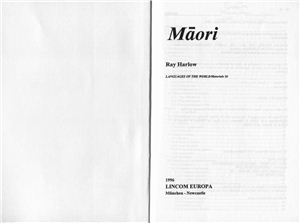M?nchen-Newcastle: Lincom Europa, 1996. - 52 p.
Maori, a member of the Easte Polynesian subgroup of the Austronesian language family, is the indigenous language of New Zealand. It is spoken by some 30,000 people, though a much greater number of people, perhaps as many as 200,000 have some knowledge of the language. Recently, Maori has been the subject of intense efforts to ensure its survival and development. In its phonology, morphology and syntax, it is very representative of its subgroup. It has little in the way of inflexional morphology, most morphosyntactic categories such as case, tense, even number being expressed at the level of phrase, not the word. Like other Polynesian languages, its pronoun system distinguishes three numbers, singular, dual and plural, and exclusive vs. inclusive first person.
This sketch of grammar of Maori provides an account of the basic VSX sentence type and of the variants of this which express discourse-related emphases. The sample text is drawn from the writings of a 19th-century elder, who has left voluminous manuscripts in Maori on a variety of areas of traditional knowledge and thought.
Maori, a member of the Easte Polynesian subgroup of the Austronesian language family, is the indigenous language of New Zealand. It is spoken by some 30,000 people, though a much greater number of people, perhaps as many as 200,000 have some knowledge of the language. Recently, Maori has been the subject of intense efforts to ensure its survival and development. In its phonology, morphology and syntax, it is very representative of its subgroup. It has little in the way of inflexional morphology, most morphosyntactic categories such as case, tense, even number being expressed at the level of phrase, not the word. Like other Polynesian languages, its pronoun system distinguishes three numbers, singular, dual and plural, and exclusive vs. inclusive first person.
This sketch of grammar of Maori provides an account of the basic VSX sentence type and of the variants of this which express discourse-related emphases. The sample text is drawn from the writings of a 19th-century elder, who has left voluminous manuscripts in Maori on a variety of areas of traditional knowledge and thought.

